
- •Answer these questions:
- •Are the following statements true or false?
- •Match words from the two boxes to find the exterior car parts:
- •Complete the sentences with the following words (exterior design):
- •Complete the sentences with the following words (interior design):
- •Here are some factors people consider buying a car. Match the factors with the definitions.
- •Read and translate this extract in written form.
- •Study the following information:
- •Complete the text ‘a handmade car’ with the following words.
- •Find the words hidden in the jumbles.
- •Internal combustion engine
- •Work with your partner to describe position of car components. Use the following phrases:
- •Match English word combinations with their equivalents in Ukrainian:
- •Match the word with its definition:
- •Translate this extract in written form:
- •Describe the components from the box below using words used to describe shape of car parts.
- •Find the words hidden in the jumbles.
- •Complete the text (a tour of a car factory) with the following words:
- •Complete the table:
- •Now complete the sentences with the words from the table:
- •Read and translate this extract:
- •Study the following information:
- •Match the words from these two boxes to make expressions:
- •Study the following information:
- •Match the expressions above with the following definitions:
- •Translate the sentences into Ukrainian:
- •Work in small groups to have the following meeting:
- •Complete the sentences about materials with words given below :
- •Translate this extract in written form:
- •Read and discuss the following passage. What do you know about traffic rules of our country? Do you obey them?
- •Answer these questions:
- •Complete the table:
- •What car parts are made of what materials? Pay attention to glass, leather, plastic, rubber, steel, textile, wood and others.
- •Read “The Mini Story”. Which three paragraphs are from the same article and which one is from a fashion magazine? Put the paragraphs from the article in the correct order.
- •Answer these questions:
- •Here are some factors people consider when buying a car. Match the factors with the definitions.
- •Are these sentences about the text true (t) or false (f)?
- •Find the words hidden in the jumbles:
- •Match these English phrases with their equivalents in Ukrainian:
- •Now use the expressions above to complete the sentences and translate them into Ukrainian:
- •Match the words and phrases to the correct headings.
- •Put the safety features into the correct column. Which of these safety features does your or your parents’ car have?
- •Match the questions (1 – 7) with their answers (a – g):
- •Imagine you are a transport consultant brought in to advise it on how to make cars safer. Prepare and deliver a presentation of your recommendations to the representatives of the design department.
- •Fill the missing words in. The first one has been done for you. Use them in the sentences of your own.
- •Read and translate this extract in written form:
- •Rewrite the sentences with a participle clause instead of a relative one.
- •Which instrument shows you:
- •Translate the following extract in written form:
- •Find the words hidden in the jumbles.
- •Match each column of the English words with its Ukrainian equivalent.
- •Translate these sentences into Ukrainian. Find the Infinitive and state its function.
- •What are your predictions for the next ten years for instruments and switches of the car? Prepare a short report or presentation.
- •Do you think the materials are clever, fashionable or formal? Read the text about ‘Smart materials’ and check.
- •Choose the correct answer:
- •Work with your partner. Choose one of the smart materials in the text. Think of five interesting ways it could be used. Compare your ideas with other students.
- •Find a better and cheaper way to produce parts and the auto industry takes notice! For example, hydroformed parts offer weight, design and cost advantages over stampings.
Internal combustion engine
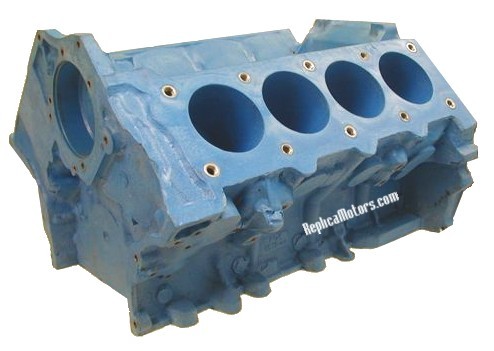 A
car engine looks like a large block of metal. And it is. It is a
large block of cast iron. In this block there are round holes. These
holes are the cylinders. The cylinder block of a car usually has four
or six cylinders. In the cylinder the power of petrol is controlled.
In each cylinder there is a piston. It can move up and down inside
the cylinder. Its shape is like the bottom half of a bottle. It has
cast iron rings round it. These piston rings help it to fit tightly
inside the cylinder. A connecting rod comes from inside the piston.
The top of each cylinder is covered. There are three holes in the
top. Two are for valves which open and shut. These are the inlet
valve and the exhaust valve. The other hole is for the sparking plug.
The sparking plug ignites (fires) the mixture of air and petrol by
means of a spark and causes it to explode. When the inlet valve
opens, a mixture of air and petrol is sucked into the cylinder. The
mixture fills the space above the pistons. When the inlet valve is
open the exhaust valve is closed. Smoke and gases remain after the
explosion of the petrol and air mixture. When the exhaust valve
opens, the smoke and gases are pushed out of the cylinder.
A
car engine looks like a large block of metal. And it is. It is a
large block of cast iron. In this block there are round holes. These
holes are the cylinders. The cylinder block of a car usually has four
or six cylinders. In the cylinder the power of petrol is controlled.
In each cylinder there is a piston. It can move up and down inside
the cylinder. Its shape is like the bottom half of a bottle. It has
cast iron rings round it. These piston rings help it to fit tightly
inside the cylinder. A connecting rod comes from inside the piston.
The top of each cylinder is covered. There are three holes in the
top. Two are for valves which open and shut. These are the inlet
valve and the exhaust valve. The other hole is for the sparking plug.
The sparking plug ignites (fires) the mixture of air and petrol by
means of a spark and causes it to explode. When the inlet valve
opens, a mixture of air and petrol is sucked into the cylinder. The
mixture fills the space above the pistons. When the inlet valve is
open the exhaust valve is closed. Smoke and gases remain after the
explosion of the petrol and air mixture. When the exhaust valve
opens, the smoke and gases are pushed out of the cylinder.
THE FOUR-STROKE CYCLE
T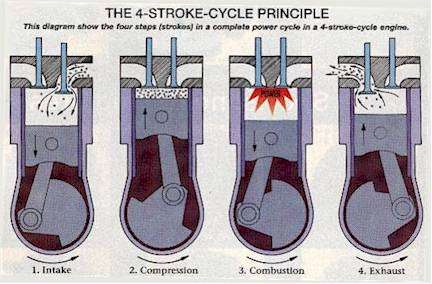 o
complete the firing cycle the piston must move along the cylinder
four times. These movements called strokes.
o
complete the firing cycle the piston must move along the cylinder
four times. These movements called strokes.
The suction (drawing in, intake) stroke.
In this stroke the piston is moving down the cylinder. The inlet valve is open. A mixture of air and petrol is drawn into the cylinder above the piston.
The compression (pressing together) stroke.
In this stroke the piston is moving up the cylinder. Both valves are closed. The piston moves up as far as it can. It pushes the mixture of air and petrol in front of it. It compresses it into the space above the cylinder.
The explosion (firing, power) stroke.
In this stroke, the spark fires the mixture and it explodes. The energy released by the burning mixture forces the piston down the cylinder.
The exhaust (emptying out) stroke.
In this stroke the piston is moving up the cylinder. The exhaust valve is open. Smoke and gases remain after the explosion. The piston pushes them in front of it. They are pushed through the exhaust valve opening. They leave the cylinder through the pipe. Now the cycle begins again.
THE CARBURETOR
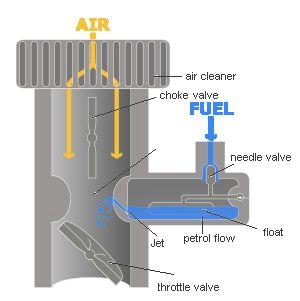
The carburetor has two main parts. There is a container (the chamber) which controls the flow of petrol. The pump forces the petrol through a pipe into the chamber. If the chamber is full, the float rises. This causes the needle valve to close. Petrol cannot enter. As the chamber empties, the float sinks. The valve opens. More petrol enters the chamber. There is also a choke tube. This tube is open at the top so that air can be sucked in. Pipes lead from the bottom of the tube to the inlet valves of the cylinders. The air and petrol mixture is sucked into the cylinder. This flow of mixture is controlled by a throttle valve. This is a round piece of metal like a large coin. It is moved by the accelerator pedal.
A small pipe leads from the chamber to the choke tube. The petrol flows through this. There are very small holes (jets) at the end of the pipe. As the induction stroke sucks air down the tube, it also sucks petrol through these jets. The petrol is broken up into thousands of very small drops to form a vapor. It mixes with the air. The mixture is sucked into the cylinders. When the accelerator pedal is pushed down, the throttle is opened. More air is sucked into the carburetor. More petrol and air mixture goes to the cylinders. The explosions in the cylinders are stronger. The car goes more quickly. When the pedal is let out, the throttle closes. There is less mixture. The explosions are weaker. The car goes more slowly.
The carburetor. Gasoline in its raw liquid form will not burn satisfactory to operate an internal-combustion engine. It must first be broken up into small drops, or atomized. After being atomized, the gasoline is vaporized and mixed with air in proper proportions for combustion. While these proportions vary slightly for different makes of engines, one part of gasoline to fifteen parts of air by mass is the average mixture used. The carburetor, therefore, is a device which automatically vaporizes and mixes the gasoline and air in the proper proportions necessary for starting, idling, acceleration, and power at various speeds.
THE CRANKSHAFT
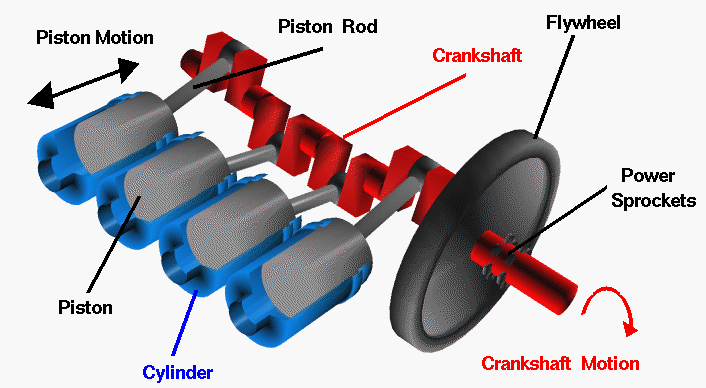
The piston goes up and down but the car wheels go round. So something must change the up-and-down movement. The connecting rod is connected to the piston. The connecting rod can swing from side to side. The big end is connected to a shaft (the crankshaft). The crankshaft can move round inside the big end. As the piston goes up and down, the connecting rod causes the crankshaft to go round.
When you ride a bicycle, your legs go up and down. The pedals and the chain wheel go round. The movement of the connecting rod is like your leg movement. So the connecting rod causes the crankshaft to go round. This circular movement goes through the gears to the car wheels
THE CAMSHAFT
A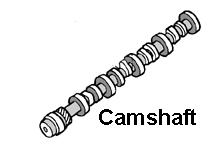 s
the crankshaft turns, it turns another shaft. This is the camshaft.
There is a wheel with teeth at one end of the crankshaft. This wheel
is connected by a chain to a bigger wheel. This bigger wheel is at
the end of the camshaft. So when the crankshaft turns, the camshaft
turns too. The camshaft has cams for each cylinder. They open and
close the inlet and exhaust valves on each cylinder.
s
the crankshaft turns, it turns another shaft. This is the camshaft.
There is a wheel with teeth at one end of the crankshaft. This wheel
is connected by a chain to a bigger wheel. This bigger wheel is at
the end of the camshaft. So when the crankshaft turns, the camshaft
turns too. The camshaft has cams for each cylinder. They open and
close the inlet and exhaust valves on each cylinder.
The cams turn with the shaft. As the high part of the cam comes up, it pushes up a rod. This rod pushes up one of a lever (the rocker arm) the other end of the lever pushes down the valve and opens it.
On each valve there is a strong spring. As the lower part of the cam comes round, the spring forces the rocker arm up. This closes the valve. The turning of the shaft is set in a certain way. It makes the inlet and exhaust valves open and shut at the right time.
There is a gear wheel in the middle of the chamber of the camshaft. It does two things. It turns the distributor. It works the oil pump.
The camshaft turns the distributor. The distributor distributes electricity to the sparking plug. The sparking plug fires the petrol and air mixture in the cylinder, at the right time in the firing cycle. So the camshaft controls the firing cycle.
THE BATTERY AND COIL
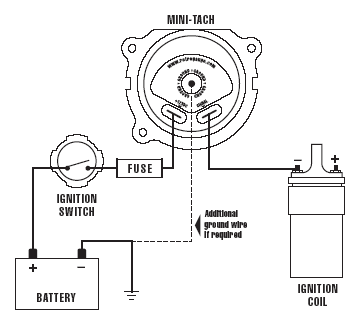
The battery is used to store electricity. The electrical pressure (voltage) of a car battery is only 12 volts. When high voltage electricity jumps a space between two points it causes a spark. This happens in the sparking plug. A voltage of about 7,000 volts will cause a good spark. How do we get 7,000 volts from a 12-volt battery?
The coil does it. The coil is really two coils of wire: the primary coil and the secondary coil. The electricity (12 volts) from the battery flows through the primary coil. Suddenly stopping the flow to the primary coil causes a very strong flow in the secondary coil. The flow through the primary coil is stopped by the contact breaker.
T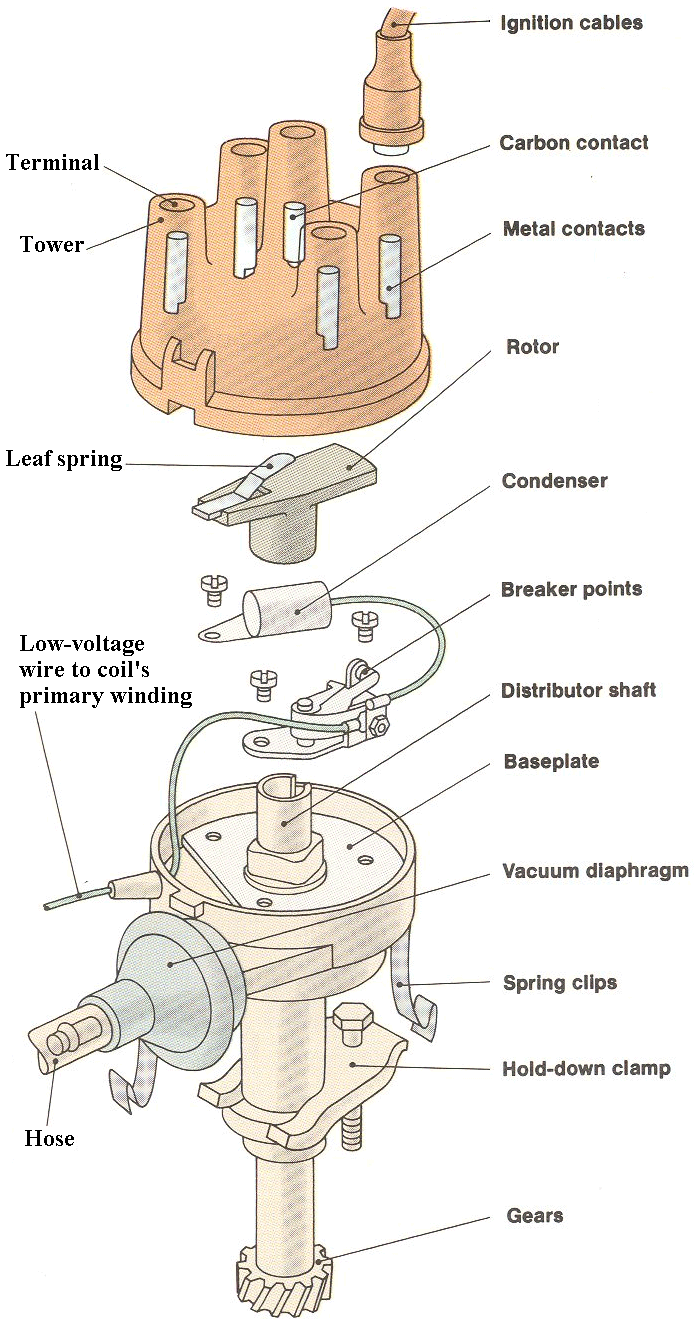 HE
CONTACT BREAKER AND THE DISTRIBUTOR
HE
CONTACT BREAKER AND THE DISTRIBUTOR
The contact breaker stops or breaks the flow of electricity in the primary coil. The distributor distributes the high voltage electricity to the sparking plugs.
The electricity from the primary coil flows through the centre of the distributor. This rod is turned by the camshaft. There are points in the contact breaker. The points can be opened so as to break the flow of electricity to the primary coil. The points are opened by a cam. They are closed by a spring.
The cam of a four-cylinder engine fits on the rod from the camshaft. It turns when the rod turns. Each corner of the cam presses on the contact breaker. This opens the points of the contact breaker. (A condenser stops any spark at these points) Now high-voltage electricity flows through the secondary coil to the distributor rotor arm.
The rotor arm is above the contact breaker cam. It is turned by the same rod from the camshaft. As the rotor arm goes round it touches points. Each of these leads to a sparking plug. Each time the arm touches a point the contact breaker points are also open. Then high-voltage electricity flows from the secondary coil to the rotor arm. From the rotor arm it goes to the sparking plug. This causes a spark.
Let us look at this again. The cam opens the points. The flow of electricity to the primary coil stops. High-voltage electricity flows in the secondary coil. It flows through the rotor arm to the sparking plugs. The cam turns. The points close. Electricity flows again into the primary coil. The rotor arm turns also. Contact with the sparking plug is broken. All this is controlled from the camshaft.
THE BATTERY AND DYNAMO
The battery only stores electricity. If we use too much, all the electricity will be gone. So something must put electricity back into the battery. This is done by the dynamo. The dynamo is a small machine that makes electricity. It is turned by the crankshaft through the belt. (This belt also turns the cooling fan.)
The electricity from the dynamo flows into the battery. This keeps the battery full of electricity (recharged). A small instrument (the voltage regulator) stops too much electricity from flowing into the battery (overcharging). So the dynamo recharges the battery when the engine is running.
